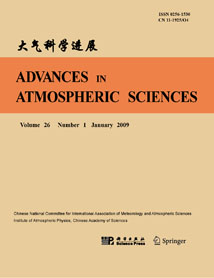| [1] |
LI Yangchun, XU Yongfu,
2012: Uptake and Storage of Anthropogenic CO2 in the Pacific Ocean Estimated Using Two Modeling Approaches, ADVANCES IN ATMOSPHERIC SCIENCES, 29, 795-809.
doi: 10.1007/s00376-012-1170-4
|
| [2] |
Jin Xiangze, Zhang Xuehong, Zhou Tianjun,
1999: Fundamental Framework and Experiments of the Third Generation of IAP/ LASG World Ocean General Circulation Model, ADVANCES IN ATMOSPHERIC SCIENCES, 16, 197-215.
doi: 10.1007/BF02973082
|
| [3] |
Jiangbo JIN, Xiao DONG, Juanxiong HE, Yi YU, Hailong LIU, Minghua ZHANG, Qingcun ZENG, He ZHANG, Xin GAO, Guangqing ZHOU, Yaqi WANG,
2022: Ocean Response to a Climate Change Heat-Flux Perturbation in an Ocean Model and Its Corresponding Coupled Model, ADVANCES IN ATMOSPHERIC SCIENCES, 39, 55-66.
doi: 10.1007/s00376-021-1167-y
|
| [4] |
Bohua Huang, James L. Kinter III, Paul S. Schopf,
2002: Ocean Data Assimilation Using Intermittent Analyses and Continuous Model Error Correction, ADVANCES IN ATMOSPHERIC SCIENCES, 19, 965-992.
doi: 10.1007/s00376-002-0059-z
|
| [5] |
Xin LI, Chongyin LI,
2017: The Tropical Pacific-Indian Ocean Associated Mode Simulated by LICOM2.0, ADVANCES IN ATMOSPHERIC SCIENCES, 34, 1426-1436.
doi: 10.1007/s00376-017-6176-5
|
| [6] |
Xu Yongfu,
1992: The Buffer Capability of the Ocean to Increasing Atmospheric CO2, ADVANCES IN ATMOSPHERIC SCIENCES, 9, 501-510.
doi: 10.1007/BF02677083
|
| [7] |
Zhang Xuehong, Liang Xinzhong,
1989: A Numerical World Ocean General Circulation Model, ADVANCES IN ATMOSPHERIC SCIENCES, 6, 44-61.
doi: 10.1007/BF02656917
|
| [8] |
Bao Ning, Zhang Xuehong,
1991: Effect of Ocean Thermal Diffusivity on Global Warming Induced by Increasing Atmospheric CO2, ADVANCES IN ATMOSPHERIC SCIENCES, 8, 421-430.
doi: 10.1007/BF02919265
|
| [9] |
Zhou Guangqing, Zeng Qingcun,
2001: Predictions of ENSO with a Coupled Atmosphere-Ocean General Circulation Model, ADVANCES IN ATMOSPHERIC SCIENCES, 18, 587-603.
doi: 10.1007/s00376-001-0047-8
|
| [10] |
Yu Yongqiang, Yu Rucong, Zhang Xuehong, Liu Hailong,
2002: A Flexible Coupled Ocean-Atmosphere General Circulation Model, ADVANCES IN ATMOSPHERIC SCIENCES, 19, 169-190.
doi: 10.1007/s00376-002-0042-8
|
| [11] |
XU Yongfu, LI Yangchun, and CHU Min,
2013: A Global Ocean Biogeochemistry General Circulation Model and its Simulations, ADVANCES IN ATMOSPHERIC SCIENCES, 30, 922-939.
doi: 10.1007/s00376-012-2162-0
|
| [12] |
Zhang Ronghua, Zeng Qingcun, Zhou Guangqing, Liang Xinzhong,
1995: A Coupled General Circulation Model for the Tropical Pacific Ocean and Global Atmosphere, ADVANCES IN ATMOSPHERIC SCIENCES, 12, 127-142.
doi: 10.1007/BF02656827
|
| [13] |
BUHE Cholaw, Ulrich CUBASCH, LIN Yonghui, JI Liren,
2003: The Change of North China Climate in Transient Simulations Using the IPCC SRES A2 and B2 Scenarios with a Coupled Atmosphere-Ocean General Circulation Model, ADVANCES IN ATMOSPHERIC SCIENCES, 20, 755-766.
doi: 10.1007/BF02915400
|
| [14] |
Boyin HUANG, Vikram M. MEHTA,
2010: Influences of Freshwater from Major Rivers on Global Ocean Circulation and Temperatures in the MIT Ocean General Circulation Model, ADVANCES IN ATMOSPHERIC SCIENCES, 27, 455-468.
doi: 10.1007/s00376-009-9022-6
|
| [15] |
MAO Jiafu, WANG Bin, DAI Yongjiu,
2009: Sensitivity of the Carbon Storage of Potential Vegetation to Historical Climate Variability and CO2 in Continental China, ADVANCES IN ATMOSPHERIC SCIENCES, 26, 87-100.
doi: 10.1007/s00376-009-0087-z
|
| [16] |
Huang Ruixin, Jin Xiangze, Zhang Xuehong,
2001: An Oceanic General Circulation Model in Pressure Coordinates, ADVANCES IN ATMOSPHERIC SCIENCES, 18, 1-22.
doi: 10.1007/s00376-001-0001-9
|
| [17] |
LI Jianglong, ZHANG Xuehong, YU Yongqiang, DAI Fushan,
2004: Primary Reasoning behind the Double ITCZ Phenomenon in a Coupled Ocean-Atmosphere General Circulation Model, ADVANCES IN ATMOSPHERIC SCIENCES, 21, 857-867.
doi: 10.1007/BF02915588
|
| [18] |
Yongqi GAO, Helge DRANGE,
2004: The Effect of Diapycnal Mixing on the Ventilation and CFC-11 Uptake in the Southern Ocean, ADVANCES IN ATMOSPHERIC SCIENCES, 21, 755-766.
doi: 10.1007/BF02916372
|
| [19] |
LIU Hailong, ZHANG Xuehong, LI Wei, YU Yongqiang, YU Rucong,
2004: An Eddy-Permitting Oceanic General Circulation Model and Its Preliminary Evaluation, ADVANCES IN ATMOSPHERIC SCIENCES, 21, 675-690.
doi: 10.1007/BF02916365
|
| [20] |
YU Yongqiang, ZHANG Xuehong, GUO Yufu,
2004: Global Coupled Ocean-Atmosphere General Circulation Models in LASG/IAP, ADVANCES IN ATMOSPHERIC SCIENCES, 21, 444-455.
doi: 10.1007/BF02915571
|















 AAS Website
AAS Website 
 AAS WeChat
AAS WeChat 
 DownLoad:
DownLoad: